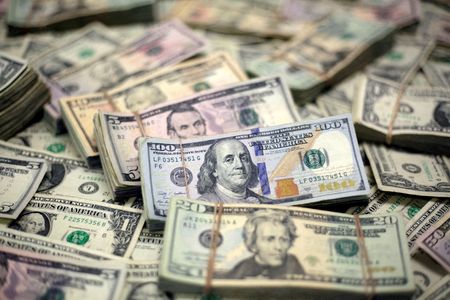By Chuck Mikolajczak
NEW YORK (Reuters) – The yen rose sharply on Wednesday in a move that sparked speculation as the result of another intervention from Japanese officials to support the long-battered currency from multi-decade lows.
The yen has posted several outsized moves in recent days, appreciating sharply on Thursday and Friday from 38-year lows of 161.96 per dollar, sudden rallies which market participants said had the signs of currency intervention.
Bank of Japan data released on Tuesday suggested Tokyo may have spent 2.14 trillion yen ($13.5 billion) intervening on Friday. Combined with the estimated amount spent on Thursday, Japan is suspected to have bought nearly 6 trillion yen via intervention last week.
“The fact that the move is bigger than it is elsewhere seems like it points to intervention of some sort, but the timing doesn’t really make sense, it seems to be coming out of the blue as opposed to triggered by a move in volatility or a move in the spot rate,” said Karl Schamotta, chief market strategist at Corpay in Toronto.
“Potentially we are in a situation in which traders are trigger-happy, given the fact that the Bank of Japan is looming in the background and that is exacerbating underlying moves. But as it stands it is hard to tell if there is actually any intervention going on here; we’re not seeing flow data that would suggest that it is intervention at this point.”
Market participants also cited comments from Republican Presidential nominee Donald Trump on the recent strength of the dollar in a Bloomberg interview published on Tuesday as a possible cause for weakness in the dollar.
Against the Japanese yen, the dollar weakened .32% at 156.25 after falling to as low as 156.09, a level not seen since June 12.
Japan’s Ministry of Finance did not respond to requests for comment. Japan’s top currency diplomat Masato Kanda said he would have to respond if speculators caused excessive moves and there was no limit to how often authorities could intervene, Kyodo News reported.
The dollar index, which measures the greenback against a basket of currencies, was also weaker on the day, down 0.43% at 103.76 after hitting a four-month low of 103.64, as comments from several Federal Reserve officials indicated the central bank was getting closer to cutting interest rates.
The Fed’s “Beige Book” of economic activity showed a slight to modest pace of expansion from late May through early July, with firms reporting some signs of continuing softness in the labor market.
While markets only see a slim chance for a rate cut of at least 25 basis points (bps) at the Fed’s July meeting, they are completely pricing in a September reduction, according to CME’s FedWatch Tool.
The euro was up 0.37% at $1.0937 ahead of a policy meeting from the European Central Bank (ECB) on Thursday, in which it is widely expected to keep rates steady, putting the focus on comments from President Christine Lagarde for clues on the timing of the next rate cut following a 25 bps reduction in June.
Sterling strengthened 0.32% at $1.3006 and hit a one-year high against the dollar of $1.3044 on data that showed UK inflation rose slightly more than expected, dampening chances for a rate cut from the Bank of England at its upcoming meeting.
Headline inflation held at 2% on an annual basis in June against forecasts for a 1.9% increase, while closely watched services inflation came in at 5.7%.
In cryptocurrencies, bitcoin fell 0.21% at $64,556.03. Ethereum declined 0.56% at $3420.38.
(Reporting by Chuck Mikolajczak; Editing by Andrea Ricci and Nick Zieminski)












